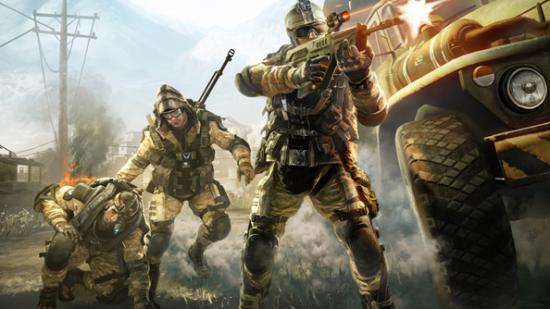Over the course of two days with Trion Worlds in and around Crytek’s nanoshiny Frankfurt HQ, earlier this month, a strange thing happened. The name stopped being funny. Slowly but surely, this apparently accidental bottling of FPS creative bankruptcy in two short syllables was washed clean, to reveal the image of the game itself – a reimagining of the multiplayer FPS as ongoing service. Think Call of Duty reimagined by Riot Games – not harvested annually until the land turns barren, but nurtured, through updates big and small, over the next half-decade. That’s Warface. Or at least, what it might become.
Warface has two modes: Versus and Co-op. There’s almost nothing new in its mechanics, but it’s best in class stuff. It wears its key influences on its kevlared sleeve, and shows off each in turn via its four Versus modes: Free for All, Plant the Bomb, Storm and the self-explanatory Team Deathmatch.
Plant the Bomb is Counter-Strike. Or rather, it encourages the same behaviours – the zen-like pursuit of intimately familiar objectives; the learned precision of a grenade bounced just so over the crest of a wall. It sees a team of soldiers sneak into one of two possible sites and set up shop with a timed explosive, leaving their opponents to scramble and mount an assault before it’s too late. Each round lasts no longer than a few minutes, with no respawns, which means two things: first, that it’s as much about loudly rooting for your last man in spectator mode as it is wielding a gun yourself. And second, that the Medic class becomes absolutely vital in a way he perhaps isn’t elsewhere.
Free for All looks CoD right in its rheumy, Quake III-powered eye and matches it for tension, using all of its own tricks – the pressure for continuous movement; the map layouts burned behind the eyes; the reliance on muscle memory to tell you what number key to press upon rounding a corner and finding your face inches from somebody else’s.
Almost nothing new. But there’s a reason that statement’s qualified – a reason that’s even now coasting in behind you on its arse, shotgun ready to blow you off your feet. It’s a “classic Crytek move”, according to exec producer Josh Howard. It’s the slide.
Movement in Warface is pedestrian – plodding, even. The anti-Quake. But a tap of the F key while running will send your generi-soldier skidding across the dirt. On paper, it’s an unnecessary embellishment. In practice, it’s everything.
Imagine you’re rounding that corner again. Warface-to-warface with an equally matched opponent. Perhaps one of you will crouch. Colour fades into binary, and in that instant there is only one question left, as has long been written in the shooter constitution: who will twitch the fastest?
Only, neither soldier shoots just yet. Both hit F. Maybe one will manage to slip into nearby cover. Or maybe the other will light up his assault rifle and pull off a jammy slide kill. Crytek promise the move will be difficult to master, and I can testify to that. But successful slide kills will be rewarded with points, and a bright yellow notice in the kill list that cascades down the right hand side of the screen for all to see.
Warface is a class-based shooter. Upon entering the lobby for a match, you’ll be faced with a choice: Rifleman, Medic, Sniper or Engineer.
In Free for All, the Rifleman is king. He can rule the roosts meant for snipers, if he’s a crack shot, or go toe-to-toe with the shotgun-toting Medic in close encounters. In the closed beta at least, the community seems to have decided that the Rifleman is jack of all trades and master of all he surveys.
Lately, however, I’ve defaulted to jabbing the Engineer’s icon in the lobby, for he carries the only cure for my lacklustre K/D ratio – claymores. Plantable anywhere, claymores reward knowledge of map layouts and the quirks of human nature with the most satisfying gift of all – a distant boom and a double kill notification, often when you’re three deaths and half a mile away.
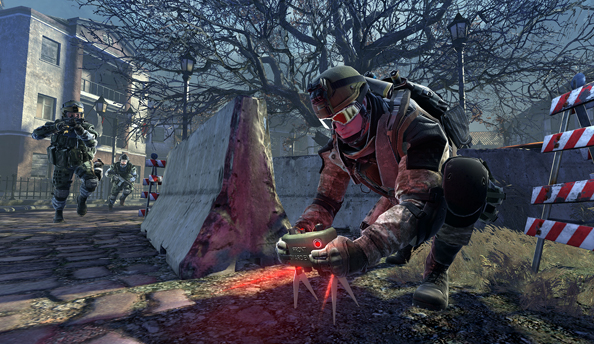
Beyond the omnipresent grenades, all classes bar the Sniper have access to a unique secondary ability designed to engender cooperation. For the Medic, it’s medkits and the insta-revive defribs that prove so useful in Plant the Bomb. For the engineer, it’s a tool used to top up teammates’ armour, sometimes the key to a crucial extra second of life in a firefight. And for the Rifleman, it’s cans of ammo to distribute among the trigger-happy.
Supporting other players via boosts to health, armour or ammo will see you rewarded with points, translated at the end of the round into XP for unlocks. Indeed, cooperation is built into the the very walls of Warface’s levels. The best crow’s nests are often unreachable without a leg-up from another player – a mechanic that frequently sees marksmen silently pair up in VOIP-less mutual support.
Crytek’s map design is, generally speaking, a quiet triumph. The developer’s Kiev studio have crafted their areas like glass-blowers might, guiding their shape to alternate between tight, twitchy corridors and open, sniper-dominated expanses. Their networks of concealed pipes, back doors and slide-holes, meanwhile, mean sneaking up on a marksman is always very much doable with a touch of cunning and a couple of well-timed slides.
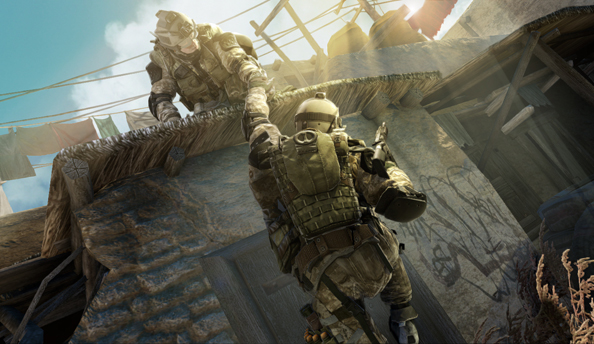
There’s one Plant the Bomb map I’m especially fond of: the unfussily named Yard. It’s typical of military shooters in its Middle Eastern urbanity, and despite other attempts at verisimilitude – in its gated homes, abandoned clothes lines and mangled marketplace – signage is functional at best. Here, a stencil-print digit is emblazoned in yellow on a brick wall, pointing the way to a nearby bomb site. There, an olive-green sign hangs apparently meaninglessly from a building which forms one corner of a vicious bottleneck. It reads, simply, ‘Internet’.
But perhaps it isn’t meaningless. In 2007, Crytek CEO Cevat Yerli flew to Korea. “It was a different planet at that time. A gaming nation, a nation of eSports, a nation of competitive gaming and cooperative gaming in a wide scale. A nation of free to play and online games, in 2007.”
Yerli embedded himself in an internet café, and watched. What he saw was a group of friends playing through several games throughout the day, one after another. Together, they would decide what to play next. “It’s not a hardcore online thing,” explained Yerli. “They actually enjoy the time. It’s social, like at a bar or a club”.
It’s this group dynamic which provided the inspiration for Gface – Crytek’s own browser-based gaming social network, to which Warface is inextricably bound.
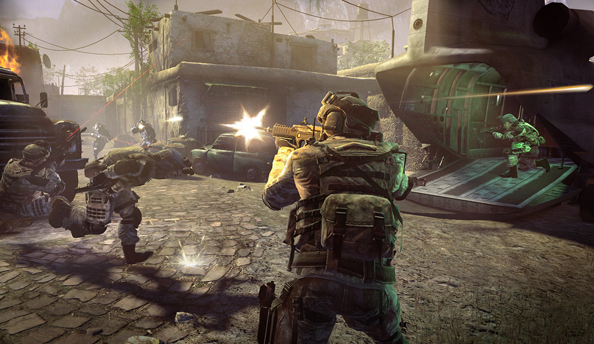
Yet another social network might not sound like a particularly enticing prospect, but Crytek have cannily built their tech around a principle of continuous interaction. That means no version mismatches, and no losing contact with friends between chat and the game session. “This is about being together there with your friends,” said Yerli. “And then once you have your friends around you, you choose what to play and you zap through the games. Zapping in this case means 15 to 30 minutes.
“You play a session, and if you are tired of that game, you go to the next game. You are sticking together for the whole day. You are going on a journey, effectively.”
Here’s what Crytek anticipate you’ll be doing in a few months’ time. In your lunchbreak, you’ll band together with your friends via Gface, and play Warface competitively. But first, you’ll need a palette cleanser – and you’ll find it in the daily missions of the game’s co-op mode.
Structurally speaking, Warface PvE has much in common with Left 4 Dead. Four soldiers – each with the word ‘Warface’ sewn into the spine of their bulletproof jackets by doting mothers – are helicoptered into a zone so hot it’s positively bubbling, and tasked with shooting their way through to the other side, either on foot or on the back of a truck.From there, they’ll hop back into the chopper to be taken to the next location.
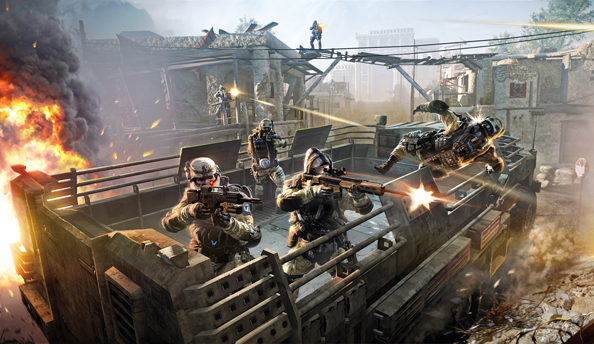
You’ll find no AI director here, though. Enemies spawn in great numbers and at various levels of elevation, usually in plain sight – their sole directive to be shot, immediately. Its arcade sensibilities are such that I’d suspect the hand of former Timesplitters devs Crytek UK at work, were they not tied up with Crysis 3’s multiplayer.
Proceedings are lent an element of tactical variation by riot-shielded opponents – who’ll have half your squad downed if you’re not careful – and climactic boss battles at the appropriate beats. In a Crytek office demo we had the easiest difficulty mode selected for us, but struggled to bring down chunky ‘gunners’ – uninspired bullet sponges, who encouraged the adoption of the same flank-and-confuse tactic ad infinitum. More promising was a staged mech battle found later in another map, which saw all classes down their usual tools and scramble for rocket-propelled grenades found, Half-Life 2 style, in self-replenishing ammo boxes. The bot possessed a glaring cockpit weak point, but made short work of our team nonetheless. Downed players can be pulled to their feet by an ally within a 10 second timer, or sit out combat until a convenient auto-respawn at the next checkpoint if the cavalry fails to respond.
Which brings me to what’s likely to be Warface’s most divisive feature – resurrection coins. Acquirable only in bulk via the in-game store, coins allow players instant revival in co-op. In practice, I found that they could be used strategically, to jump back into existence at an opportune moment – for instance, as soon as my killer’s back was turned.
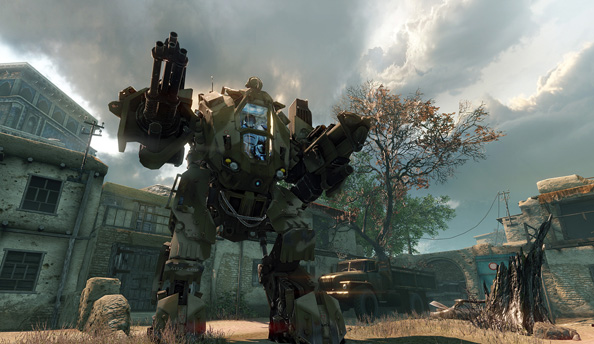
Crytek CEO Cevat Yerli described a situation in which his group failed to reach a checkpoint by such a thin margin that he wished he’d cashed in a coin to save them. “It is something for convenience,” he said. “Normally a game design like that, I’ve seen it in other games when you just [have to] wait til they get to the next checkpoint – they don’t have the mechanic to respawn at all. It’s [virtual] money for the greater good of the group.
He also told us that resurrection coins don’t feature in Warface’s Versus mode, and never will: “If it was a PvP thing we would never have done that.”
Of course, you needn’t cash in a thing. But if our session was representative of a ‘Normal’ playthrough, you can bet you and your teammates will need to finishing each others’ sentences to survive the higher difficulties without a healthy supply of coins.
Warface’s store is home to no less than three in-game currencies, though Crytek are quick to reassure that no card details are taken upfront and you “need not spend a single dollar” – not five, not 10, nor even 50 hours into the game. This is a truly free to play shooter – think Planetside 2.
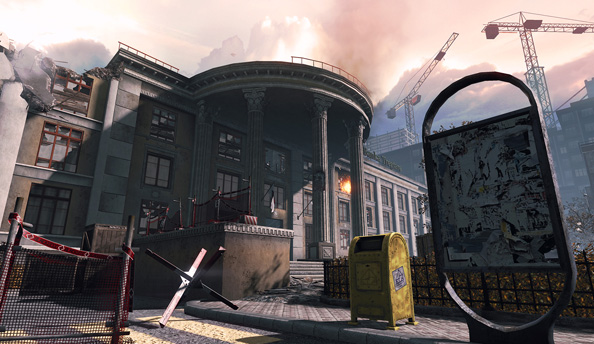
Warface Dollars are earned at the end of every match, usually in the low hundreds, and will be enough to earn you something like the R4 CQB – a machine gun to replace the engineer’s standard carbine – after a couple of hours’ play. Alternatively, gear and outfits can be purchased with real money (K), though they haven’t been purchasable during beta and Crytek are still ironing out their monetization strategy for the West. Weapon upgrades will impact stats balance and weapon feel, but the developers promise they will never outstrip Warface’s starting gear in terms of sheer firepower.
Some items, however, are only acquirable via another currency – Crowns. Crowns are earned via particularly flashy in-game exploits, or granted to those who finish within the top 10% of players on the server at the end of each day. Crown items not only offer the most compelling stat payoffs, but also a certain elite status – theirs is the most visually arresting equipment in a sea of blacks and greys. In the current beta, Crown-rich players can kit themselves out from head to toe in matching, yellow-flecked livery.
Crown Gear, however, can only be bought on a rental basis, and will expire within two weeks – meaning players will have to continually prove their worth. And that you see a player in the field decked out in Crown items, you know they’re among the best.

Elsewhere there are VIP boosters, which will temporarily increase the amount of XP and Warface Dollars earned at the end of each round. But the store’s most unusual aspect is its Random Boxes – scratchcard type affairs which see real cash exchanged for a few of several potential prizes. You’ll regularly win trinkets – small doses of XP, Warface Dollars, grenades – and if you’re really lucky, a rare item. The Boxes are compulsively designed, each costing a little less than the last. And frankly, I’m not sure how I feel about them.
Perhaps it doesn’t matter how I feel. Most of these systems are already in play in Russia, where Warface has been established since April. By May, it had reached one million users; by January of this year, five million. In the words of Josh Howard: “Warface isn’t a brand new thing – it’s a proven commodity”.
Closed beta is still ongoing and an exact release date is still tbd, but in a matter of weeks you’ll be playing Warface too. And when you do, there’s a moment at the conclusion of the tutorial you’ll remember. You’ll have been practicing slide kills, and be feeling pretty great about it. A gruff Arnie-man will come in over comms: “Put your Warface on,” he’ll advise, and you’ll laugh, as well you should. But then you’ll stop laughing, and play the PC military FPS as it should be – accessible, deep, free, and continuously updated.
I think we might still be writing about this one in 2018.
